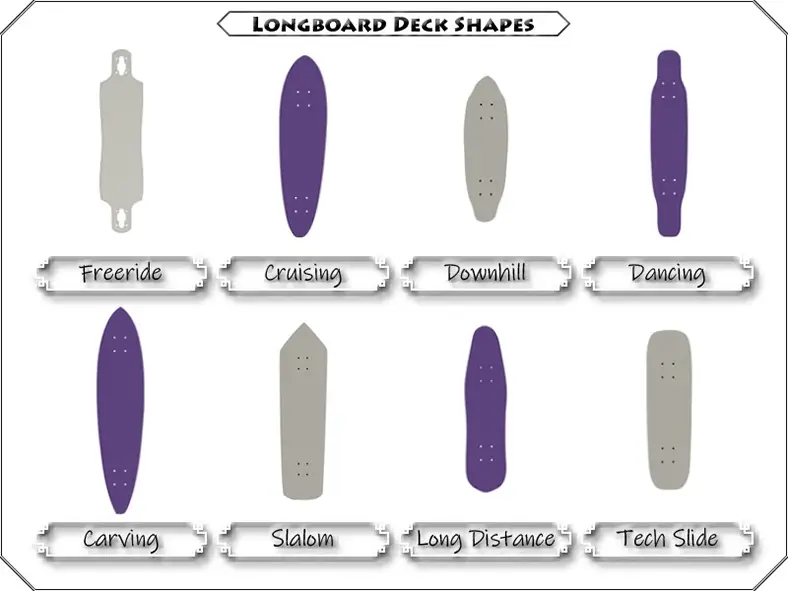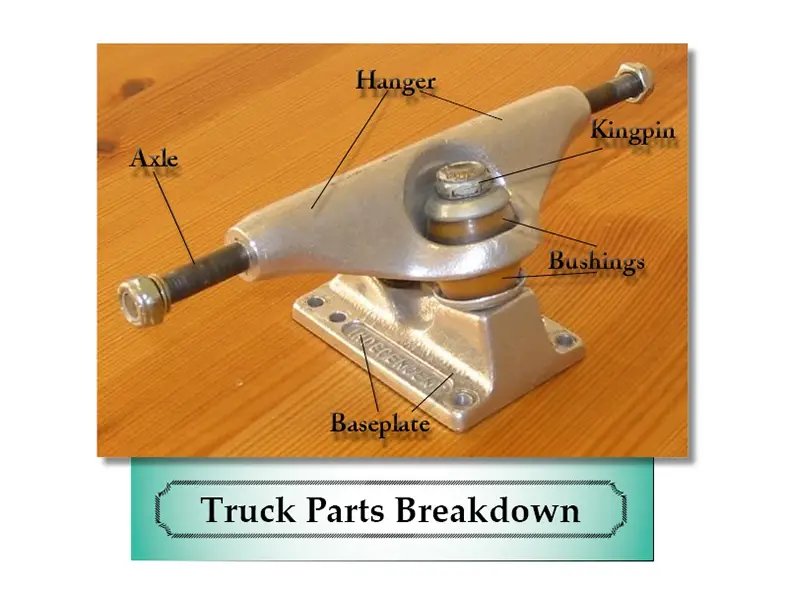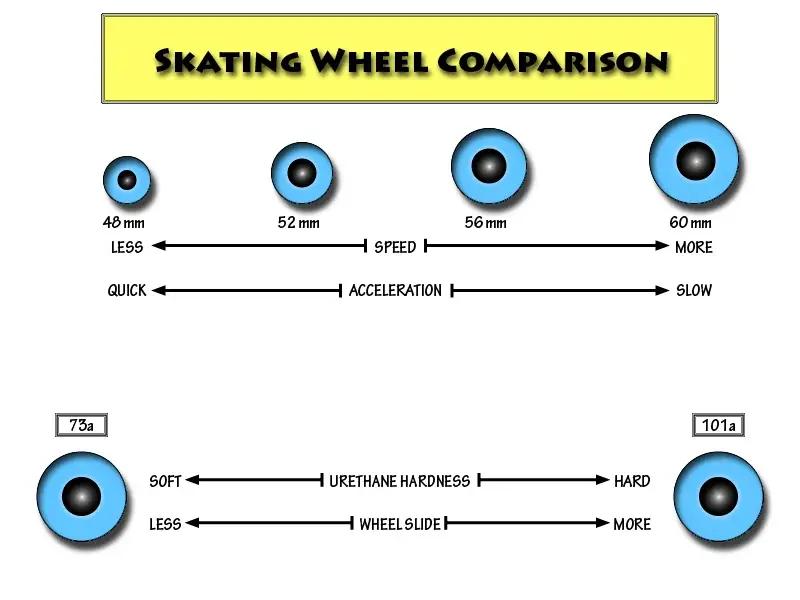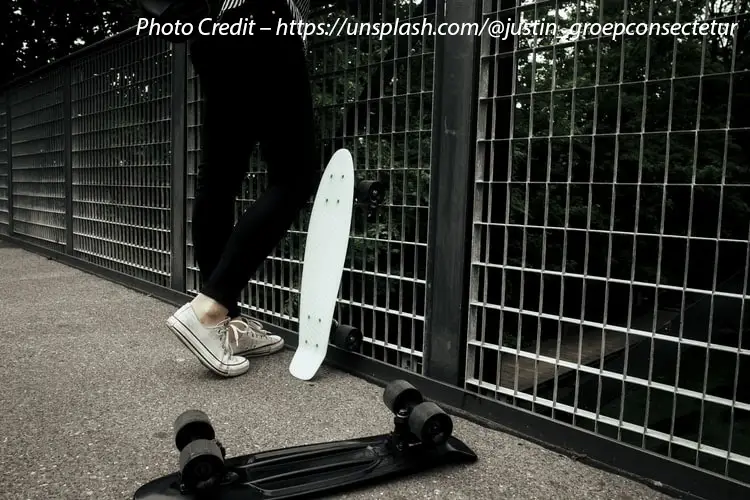People that are new to the skateboarding and longboarding scene can feel intimidated as they sort through the myriad of options they find. Maybe you skated as a teenager and now you’re a parent with children that talk about trying the sport. Or maybe you’ve never even seen a skateboard in real life, but are fascinated with the culture and vibe of the skating community. Whatever your situation, one of the very first things you’ll want to figure out before getting started on this amazing journey is, simply put:
“Should I get a skateboard or longboard?”

Longboard vs Skateboard: Length
Figuring out whether you want a skateboard or longboard is ultimately going to come down to your riding style. There are a few different features that establish the difference between the two, but the first, and most obvious, is the length.
While there are no formally recognized length standards for either industry, anything over ~36” (91.4 cm) is generally considered a longboard, and anything under is a skateboard.
As the scene has evolved, however, certain deck shapes have started to become synonymous with longboards and the longboarding subculture. The pintail deck is probably the most recognizable example of this, with pintail decks as short as 31” being marketed as “longboards” in some cases.
And indeed, the pintail’s shape hearkens back to the surfer roots of longboarding and remains an excellent design for cruising and commuting.

Here you can see the difference in deck shapes between the different styles of riding. Each shape is the result of decades of enthusiasts from the longboarding and surfer communities employing DIY-engineering, initially. It may be difficult to imagine until you’ve ridden them (or at least seen them ridden), but the unique shapes of each longboard deck are features themselves. Some designs allow for better carving, or extra stability at speed.
There can be some crossover with a few of these decks; like cruising on a freeride or carving deck, for example. If you’re really interested in a particular style of riding, consider going ahead and getting a specialized longboard. A generalist might be able to do more from the spectrum but won’t excel at much aside from cruising. Riding a pro longboard setup built for a specific riding style (or even riding location!) can make a world of difference.
Longboard vs. Skateboard: Trucks
While they might look somewhat alike to the untrained eye, skateboard and longboard trucks are actually quite different from one another. The hanger on a longboard truck will be wider to match the longboard’s deck width (150mm and 180mm are industry standards), and longboard trucks are almost always Reverse Kingpin (RKP).
Longboard Truck Breakdown

Longboard trucks can be broken down into the following core components:
- Hanger – The hanger is a triangular metal piece that makes up the largest part of the truck and supports the axle, which runs through it. The hanger itself is cradled in the baseplate, which is the rectangular piece of metal that fastens to the deck itself. The bushing will sit inside the hanger, and kingpin will through both and bolt to the baseplate.
- Hanger Width – Generally speaking, your hanger width will be relative to the width of your deck. For example, narrower cruising and carving longboards will often be equipped with 150mm hangers, while dance boards with a 9″ deck or wider will need a minimum of 180mm hanger.
- Baseplate Angle – The “baseplate angle” actually refers to the angle of the kingpin relative to the baseplate, making it a bit of a misnomer. It is actually the kingpin that is angled, but the degree is built into and thus determined by the baseplate. The baseplate angle ultimately determines how well your longboard turns. Higher baseplate angles (i.e., 50°) will allow for sharper turns due to greater deck lean and increased leverage. Conversely, lower baseplate angles (44°) reduce deck lean and leverage. This results in greater stability with a wider turning radius.
In most cases, a 50° angle allows for carving and cruising while being stable enough for the majority of downhill riding. A 44° baseplate angle with a 180mm hanger is an example of how a competitive downhill rider might set up their board; this combination offers maximum stability at high speeds with less risk of wobbling. If you’re interested, check out our best downhill longboards post.
- Deck Lean – As we mentioned earlier, both skateboards and longboards are turned by leaning on the deck. This “deck lean” results in the compression of the truck’s bushings, which results in the board following a radiused arc while rolling forward. The available amount of deck lean is determined by a number of factors, such as the tightness of the kingpin, the material composition and thickness of the bushings, and simply how much leverage you apply (how hard you lean).
Generally speaking, the tighter the kingpin is, the less deck lean you’ll have. Perhaps more salient than any of these factors is the height of the deck. The higher the deck, the more it can lean. This height can be achieved in different ways, such as taller trucks or by installing risers between the baseplate and the deck. Just keep in mind that too much deck lean and not enough height can result in wheel bite; a situation where the deck comes into contact with the wheels and stops forward motion. Immediately.
There isn’t really a “right” or “wrong” amount of deck lean. You will have to spend some time on your board and make slight adjustments here and there to find what works for you and your riding style. Generally, downhill riders opt for less deck lean and carvers usually want as much as possible.
- Flipping the Hanger – You might have heard other longboarders talking about “flipping the hanger”, but had no idea what they were talking about. Essentially, flipping the hanger makes it face the opposite direction, lowering the truck’s profile while providing greater stability. The downside is that it can lead to less responsive trucks due to the change in the hanger’s deck lean resistance. This technique is often used to lower the deck height and add stability, but be careful that you consider wheel bite when employing this tactic.
Flipping the hanger can only be done with RKP truck designs, due to their hanger being flat (unlike traditional kingpin trucks). The procedure is simple – simply remove the kingpin and flip the hanger over, then re-insert the kingpin and bolt it all back together. There is no need to rotate the bushings, though you should take the opportunity to inspect them. It is important to point out that not all hangers can be flipped. Flipping the hanger will require an axle that is offset from the pivot axis.
- Axle – The axle is a long shaft or pin that runs through the hanger and allows for the attachment of wheels to either end. Axles range in length from 129mm to 169mm; you’ll want to match the axle’s length to your hanger width and existing truck setup. If at any time you notice any wobbling while riding, closely inspect the axle for any bending.
You can check this easily by removing the axle rod and rolling it on a flat surface, the same way you might check a pool cue. If there’s any lopsided rolling at all, you’ll need to replace the axle. This isn’t something that would occur under normal cruising conditions, but if you start testing the limits of your board then expect there to be some collateral damage.
- Kingpin –The kingpin is the large bolt that goes through the bushings’ center and holds the truck’s parts together. Modern alloys have made hollow kingpins and axles more popular, as they reduce weight without compromising strength and reliability.
- Traditional vs. Reversed Kingpin – Given all the different ways you can set up your board and the ways you can customize it, this may be the most important decision you’ll make. These two categories make up the foundation of truck selection and all other choices will depend on this one. In a reverse kingpin (RKP) set up, the kingpins are facing away from each other. This has become the gold standard for longboarding, as swapping out the baseplate allows you to customize the turning radius.
Traditional kingpin setups are more commonly seen in skateboarding, as they make the board sit much higher and sacrifice stability for agility. Some aggressive carvers and competitive cruisers opt for traditional pin setups, but it usually proves to be too unstable for all but expert riders.
- Bushings –These are rings made from a soft urethane that acts as a compressible spacer between the truck’s parts. When you stand on your board and lean, it turns because the leverage compresses the bushings and brings one side of the board closer to the ground. This mechanic is what allows the board to turn.
Longboard vs. Skateboard: Wheels

Both skateboard and longboard wheels are made from urethane and are round, but that may be where the similarities end. Longboarding wheels are generally larger in diameter and are wider than skateboard wheels. Wheels for longboards are also usually softer, as they need to be more accommodating to different types of riding surfaces.
Aside from their suitability to different riding surfaces, wheels also play an important role in both acceleration and top speed. Generally speaking, smaller wheel diameters allow for faster acceleration and greater push efficiency. Larger diameter wheels, conversely, will make the board harder to accelerate by reducing push efficiency but will lead to increased top speeds.
Longboard vs. Penny Board
When people use the term “penny board”, they are most likely referring to the smaller, plastic pintail shaped decks that have emerged in the market. Australian entrepreneur Ben Mackay developed the Penny Boards brand in 2010, and his decision to use the cheaper-to-produce plastic decks that came on skateboards when he was a child ultimately led to the colloquial use of the term to describe all plastic-deck skateboards and longboards.

The name works well, as these boards can be quite a bit cheaper than their longboard cousins. Due to being made from plastic, penny decks are available in a wide variety of colors and can feature different textures as well. Textured decks made penny boards popular with longboarders that prefer to ride barefoot, as the texture provides grip for the feet without being abrasive like grip tape.
To answer any questions of “Which is better; longboard or penny board?”, let’s take a quick look at the Pros & Cons of each:
| Pros | Cons | |
| Traditional Longboard | Good boards are built to perform and to lastSafer to ride at higher speedsMore versatile – can explore multiple riding styles | More expensive point-of-entry into the sportCan be heavy and awkward to carry |
| Penny Board | Very affordable point-of-entry Lightweight and easy to carryWide variety of styles and colors | Only suitable for moderate commutingNot built for performance or longevity |
FAQ
What’s best for beginners?
Penny boards are well-suited to provide first-time longboarders with an opportunity to check it out without costing a ton of money. Penny boards cost significantly less than traditional longboards, and while there are complete setups available for less than $100, they are rarely worth such an investment. This translates into penny boards being a good choice for beginners to longboarding, particularly those unfamiliar with longboarding or skating in general.
Penny boards are essentially A-to-B boards; they allow for personal transit that is affordable and easy to carry with you everywhere you go. Some people can find carrying full-size longboards awkward and as a result, have their board with them less often. Penny boards are small and lightweight, making them incredibly easy to carry anywhere.
If you are familiar with skating already and you know you’re going to be sticking with it, it may be better to invest in a quality longboard, however. The traditional longboard will ultimately be more versatile and allow you to grow and develop your own longboarding style. Then again, if this is you and financial constraints are holding you back indefinitely – the penny board may allow you to ante into longboarding sooner. We’ve written a helpful review post covering the best longboards for beginners.
If you are exclusively interested in freestyle tricking and executing big air moves on halfpipe ramps, then skateboarding is definitely where you want to be. Skateboarders are intensely dedicated to learning increasingly difficult tricks, whereas longboarders are generally more about cruising and distance riding. If the idea of popping in some earbuds and cruising your downtown sidewalks or letting your dog pull you through the boardwalk tourists is appealing, then longboarding is for you. Santa Cruz boards are a great place to start – we’ve picked them as one of the best skateboard brands ever.

All things considered, penny boards are the most practical choice for college students. Penny boards offer the same commuting ability as entry-level longboards at a fraction of the cost, making them the responsible choice;. Granted, they aren’t useful for much more than that – but in so many ways making compromises today for the sake of having more, tomorrow, is a fundamental part of the college experience.
If you’ve got the room in your budget for it, however, your commuting experience might be more pleasant on a traditional longboard. The higher quality materials and construction will absorb much more of the pavement’s imperfection, as well as provide higher speeds and greater stability. While all this sounds amazing, it does come at the cost of more weight and larger decks.
Skateboards are ill-suited for intra-campus transit, in most cases. They are usually less push-efficient than longboards and penny boards, meaning you’ll be pushing constantly to keep moving forward. Longboards also get more flex and deck lean, allowing them to carve into their turning arc more sharply. This is ideal for navigating through pedestrian traffic and weaving around other environmental obstacles. Penny boards can navigate well enough through pedestrians and most campus infrastructure, just don’t try carving as deeply as you might on a full-size longboard.
Is it easier to ride a skateboard or longboard?
Most people are going to find it much easier riding on a longboard. Longboards are ultimately about cruising, though recently a variety of other riding styles have grown in popularity as well. Cruising, however, is the epitome of easy. With cruising, the things you need to learn come intuitively and naturally. This organic progression allows you to grow into longboarding and skating at your own pace, and it becomes much easier to explore other styles from a foundation in cruising.
Skateboards, conversely, are more about executing challenging tricks. They are designed with this in mind; there isn’t much consideration for cruising or commuting throughout the industry. In all fairness, modern bearings and wheels do allow for more push-efficiency than skateboarding’s pioneer models. That being said, there is really no comparison to be made between skateboards and longboards when it comes to cruising and the initial learning curve.
Cruising is as easy as it gets. Longboard cruising is as simple as pushing yourself forward on a flat surface until you’re up to speed. That’s about it! Once you’ve got both feet planted you can experiment with some weaving and carving to build speed, and if you’re the adventurous type you can seek out a gentle downhill slope. For info and how to cruise, check out our how to longboard guide.
Is a longboard safer than a skateboard?
Well, let’s put it this way – cruising on a longboard is going to be safer than freestyle tricking on a skateboard. In many ways, comparing skateboards to longboards is really apples & oranges, considering the fundamental differences in riding styles and how these boards are ridden.
Would you find it safer to learn how to ollie on a skateboard in the driveway, or join a downhill vertical race on a longboard? Learning to dance on a longboard at the mall, or your first “drop-in” on a halfpipe ramp? Safety is largely situational, and one can find dangerous things to do in either sport, should they choose. If you’re looking for a skateboarding/longboarding helmet we can help!
We hope the information here helped you sort through the differences between skateboards and longboards. It can seem like a lot to take in but just start with the style of skating you’re interested in doing. From there, soak in what you can and just start skating! You’ll learn more by spending time on your own board, and you’re likely to meet other skaters that will help you learn the ropes.
Until then, keep safe, and thanks for reading!






